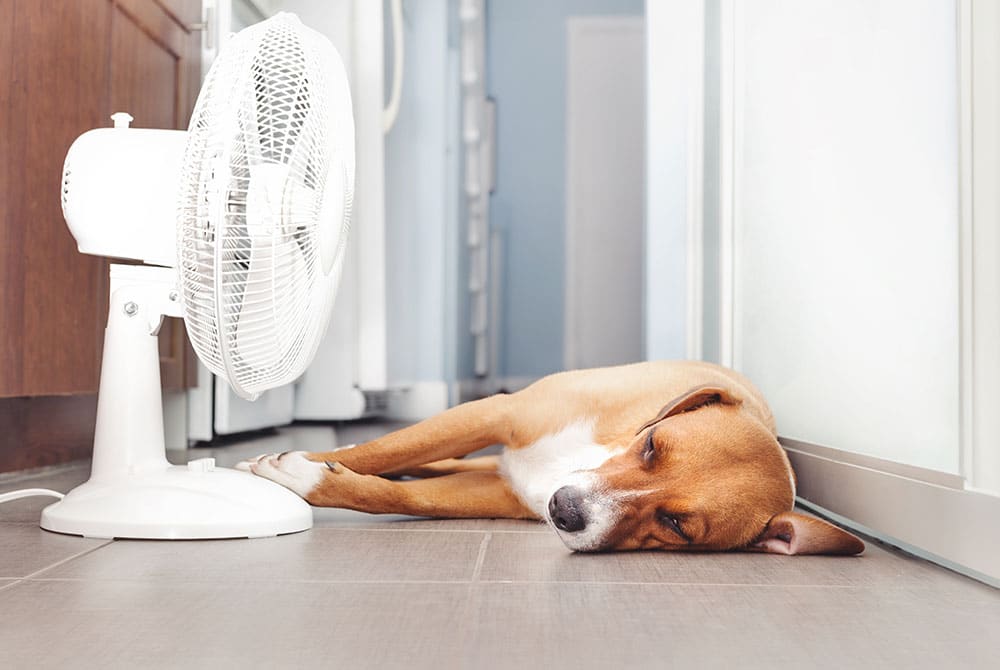It’s a beautiful early summer day and the weather is finally warmer. It’s a perfect 75 degrees out and you decide to take your dog with you on your afternoon jog. Five minutes into the run, you notice he’s panting harder and is struggling to keep up. You slow your pace and then he collapses. You rush him to your closest ER or Urgent Care and they diagnose him with heat stroke! You don’t understand. It’s not even that hot outside! How could this happen?
Even though it wasn’t very hot outside, it was a humid day. We often see heat stroke victims in late spring and early summer and it’s usually as a result of a few factors, one being high humidity. Dogs have a limited ability to sweat, blowing off the majority of their heat by panting. If it is humid outside, evaporation cannot effectively occur through the mouth and respiratory tract. This can easily lead to heat stroke. Brachycephalic, or squished faced breeds, are especially prone to heat stroke because of their small nasal passages which restrict airflow and the ability to exchange heat. Other dogs who are at risk are our older kids. Older dogs are more likely to have respiratory disease/dysfunction’s, such as laryngeal paralysis, which can inhibit adequate opening of airways. Older pups, like older humans, are also more likely to have heart disease which can make it harder to pump blood to the skin surface let alone move blood effectively through the lungs for heat and oxygen exchange.
Heat stroke is a multi-organ syndrome during which the body temperature rises to a dangerous level which causes brain damage and organ failure. The organs essentially start to cook at these higher temperatures. A normal rectal temperature for a dog is between 99.5 Fahrenheit to 102.5 Fahrenheit. Anything over 106 F results in organ enzymes breaking down, leading to multi-organ failure. Once the body temperature hits 109 F significant brain swelling occurs and your dog is guaranteed to develop clotting abnormalities that must be treated with a plasma transfusion. It can only take a few minutes of being locked in a hot car for a dog’s body temperature to reach these numbers.
Now, let’s talk a little bit about the physiology that happens. During times of heat stress, blood is shunted to the skin’s surface which allows the body to release heat through convection and radiation. I know, I know, here we are bringing up 8th grade science again. Convection occurs as heat is carried away from the body via the cooler surrounding air. Radiation occurs as heat is emitted from the body in the form of infrared rays. Under average conditions both mechanisms do an excellent job of regulating body heat. Unfortunately, when the body is under extreme heat and is working extra hard to self-regulate, all this shunting of blood to the skin’s surface pulls normal blood flow supply away from what the body considers “non vital organs”. A primary non vital organ for dogs being the stomach and intestinal tract. Without adequate blood supply to the gut, these cells start to die. Additionally, the high temperature occurring inside the body also causes breakdown of the gastrointestinal cells which leads to bacterial translocation. Fancy words that mean all of that nasty bacteria that is usually contained in their gut now has access to the blood stream and can go into circulation and get into other organs. Direct thermal injury also decreases the liver’s ability to clear out bacteria from the gut like it normally would. With all the blood flow being pushed towards the skin, the brain also doesn’t get enough blood supply. Decreased blood flow can cause part of the brain to start to die causing an alteration in mentation which literally puts the “stroke” in heat stroke.
The next nightmare to happen is the release of a significant number of inflammatory cytokines; these are proteins that are a vital part of the immune system. The massive number of cytokines released causes Systemic Inflammatory Response Syndrome (SIRS). Once SIRS occurs, it really hits the fan. SIRS causes systemic venous dilation which causes severe hypotension (low blood pressure). This low blood pressure further decreases blood supply to the brain and vital organs.
Thermal injury also damages the blood vessel walls leading to platelets forming microvascular clots which is a major contributor to Multiple Organ Dysfunction Syndrome (MODS). MODS is when two or more organs fail simultaneously. Muscle gets damaged through direct thermal injury which releases a protein called myoglobin into the blood stream. Myoglobin helps transport oxygen to the muscle cells. When a bunch of myoglobin is leaked from the muscle cells this goes to the kidneys where it is normally filtered out. At high numbers, though, the kidneys become overwhelmed and are pushed into failure. Hopefully, this is all starting to make sense as to why your vet freaks out about your dog being outside on hot days.
Signs of heat stroke can start as lethargy, drooling or excessive panting and then can quickly progress to vomiting, diarrhea, high heart rate, stumbling and collapse. The majority of cases end up carried or stretchered into the hospital, pouring out bloody diarrhea with a decreased responsiveness. This can quickly progress to seizures, coma, and death. Petechiation is another key sign we look out for with heat stroke victims. Petechiation looks like small red or purple spots and is on the skin or gums. Typically, we see these dots first on the inside of the ears or belly and this is a sign of advanced heat stroke. Petechiation is a sign of the blood vessels leaking and the body not being able to effectively form a clot.
Treatment involves external cooling, aggressive IV fluids, correcting the low blood pressure, using broad spectrum antibiotics, controlling seizures with anticonvulsants and giving plasma to help correct clotting disorders. Blood work will be done multiple times to monitor organ function as well as near constant blood pressure monitoring and in severe cases constant monitoring for heart arrhythmias developing.
Heat stroke is one of the worst things we see in emergency medicine. Not only does it cause multi-organ failure, but it can also take days before the full extent of damage is able to be appreciated. The severe cases that aren’t euthanized on presentation, will end up staying in the hospital for at least 3-5 days and unfortunately many are still lost. Patients are less likely to survive if clotting abnormalities are present or if persistent neurologic abnormalities are seen. The first 24 hours are the most critical, but again, delayed organ damage can occur. These cases will cost several thousands of dollars just in the first 24 hours.
If you think your dog is suffering from heat stroke immediately move them indoors or into a shady area. Wet them down with cool (NOT cold) water and then go straight to your closest ER or Urgent Care facility.
Of course, preventative care is the best. When it is hot or humid outside don’t take your dogs on walks or play outside. Keep them indoors in the air conditioning. Let them outside just to go to the bathroom. Never leave them in the car even if it’s “just for a few minutes”. Always make sure they have access to fresh water. Whenever there is a heat warning for us, that counts for our pets too. Let’s all have a great summer, better said, let’s all have a cool summer!








Leave A Comment